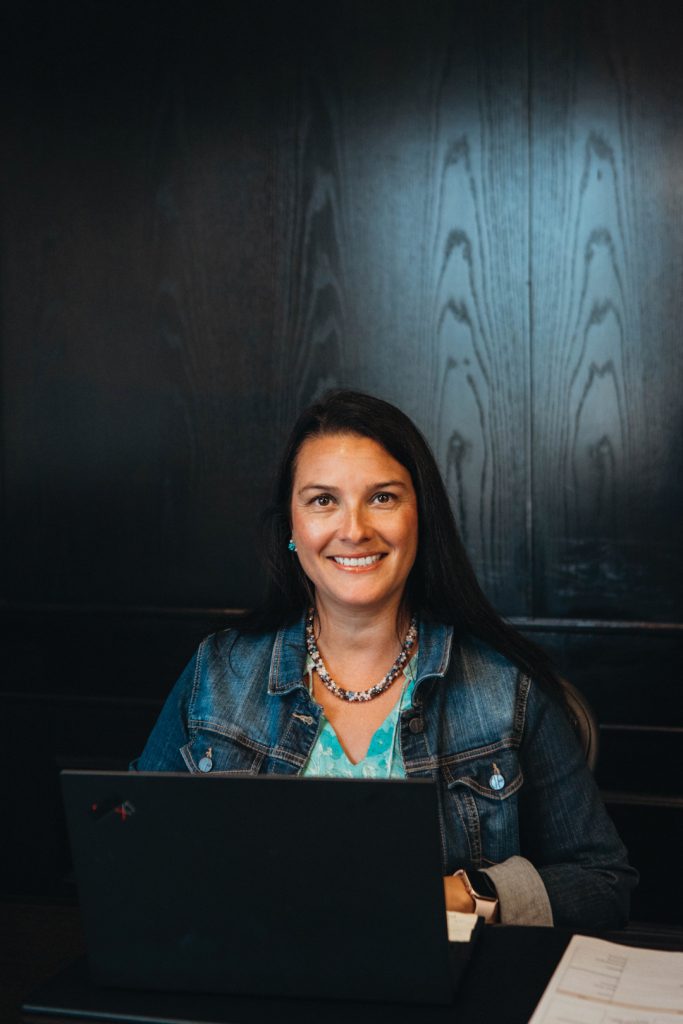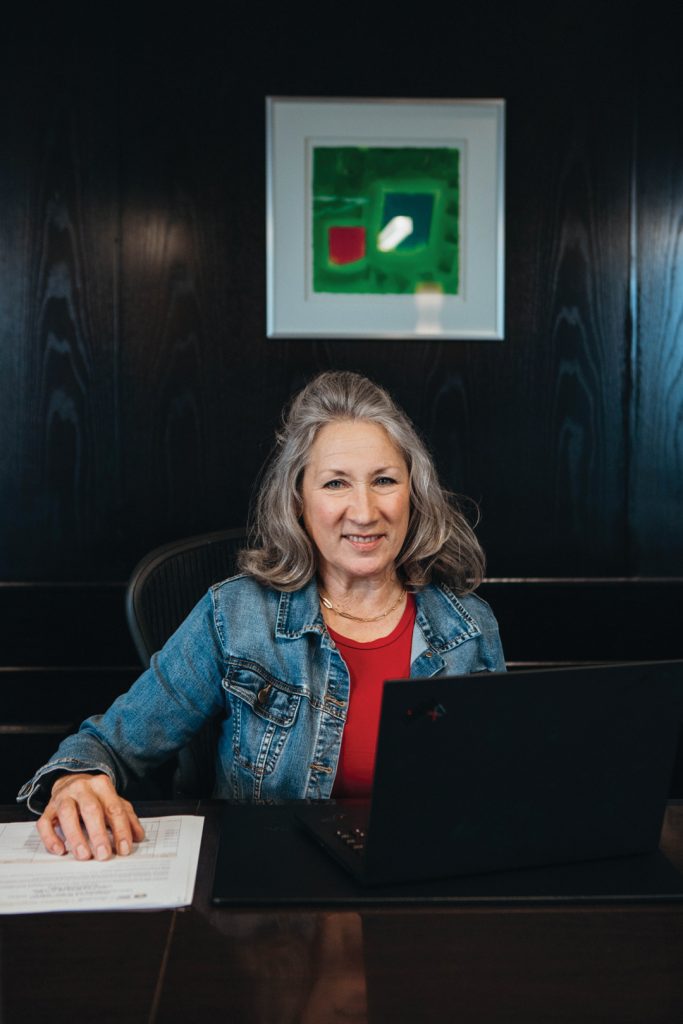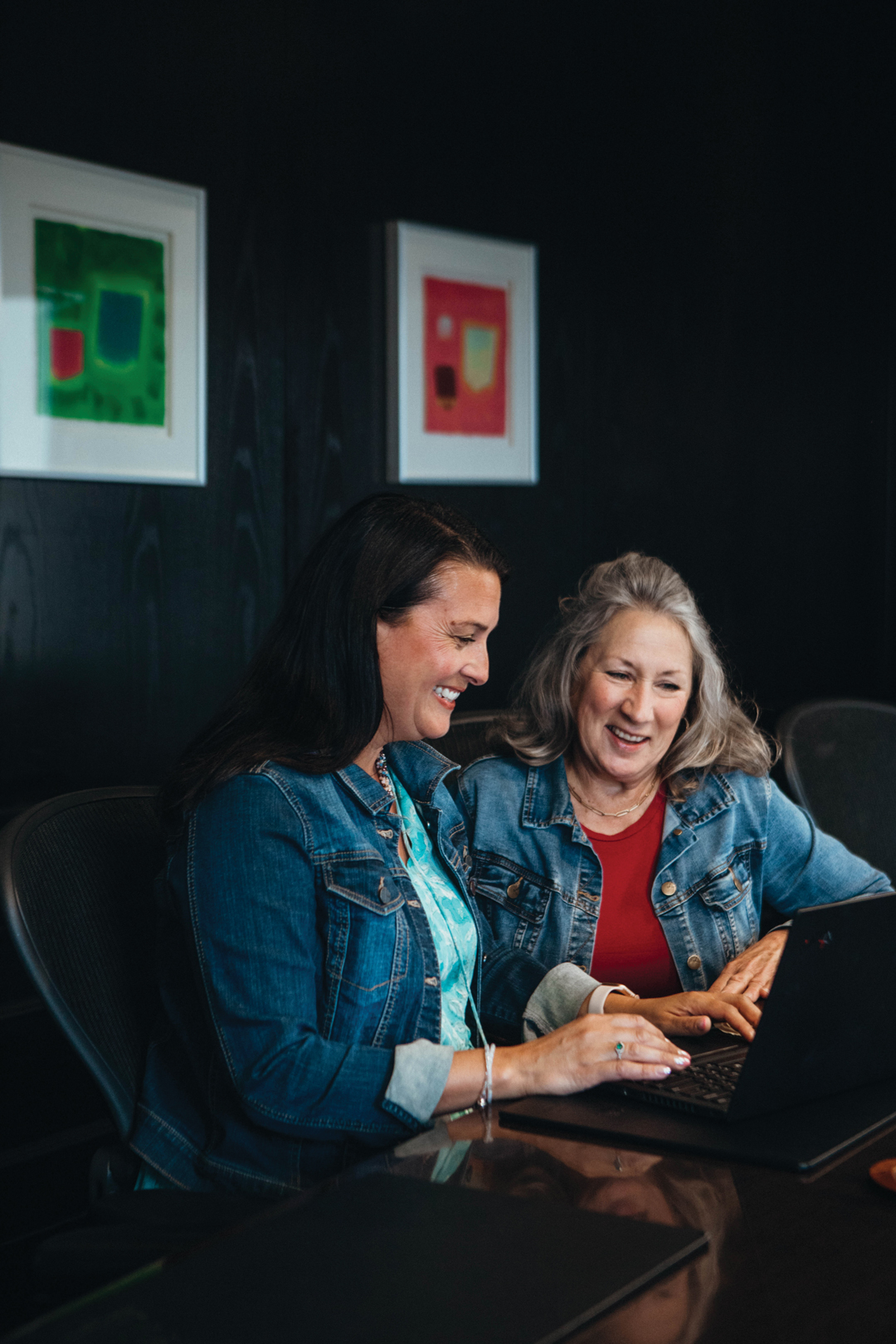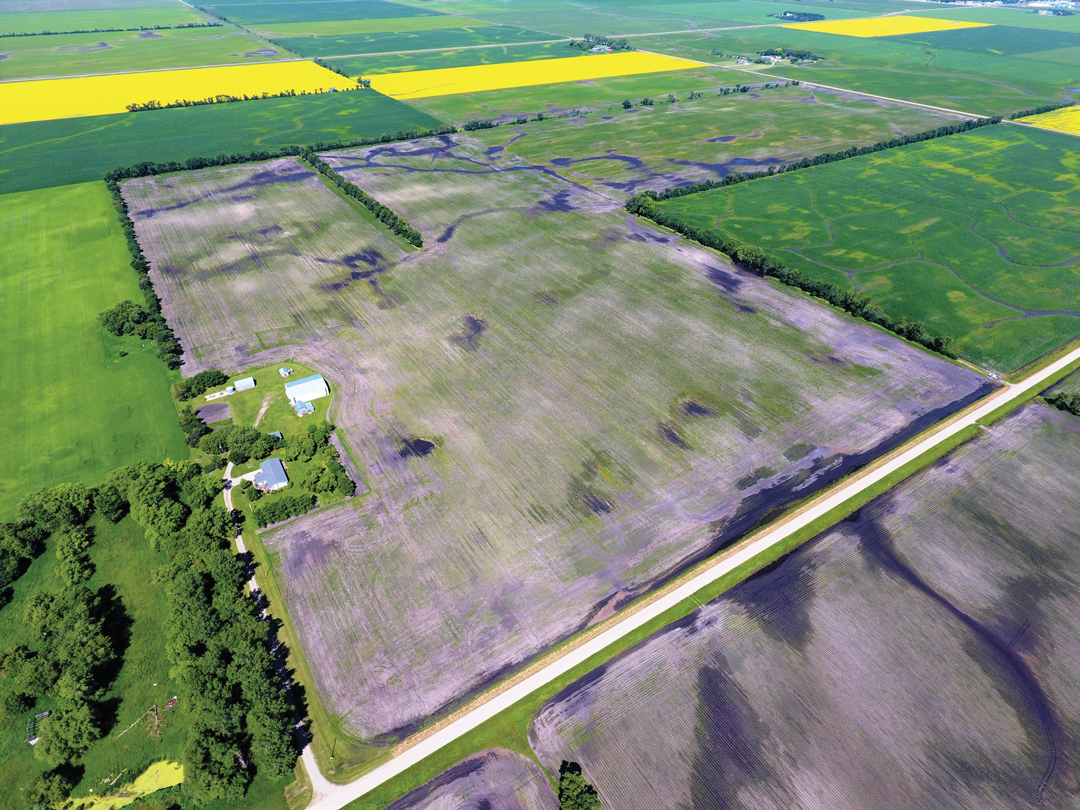GET ON BOARD
BY MELANIE EPP • PHOTOS: PAULA CAMPBELL
Tara Sawyer has always been interested in ag politics. Even when her kids were very young, dinner conversations centred around governance and policy. She was keen to join a commodity board, but her priorities were farm and family. During this time, she attended meetings and conferences alongside her husband Matt, who has served on multiple boards. As her children grew more independent, the timing was right, she said. Five years ago, without a word to her family, she put her name forward to serve as an Alberta Barley director-at-large. “I never thought you had the right to complain if you’re not willing to put in the work,” she said. “I felt an obligation to contribute. It’s important for farmers’ voices to be at the table.” In 2019 she was elected the first female chair of Alberta Barley and now serves as Alberta Grains interim chair.
While Sawyer was largely self-motivated in her desire to contribute, agricultural boards increasingly work to recruit candidates with a greater diversity of skillsets and experience to fill leadership roles as regional representatives and directors This most notably includes women but goes beyond gender. Variety in the ag leadership context extends to age, farm size and geographic region.
A recent Alberta study indicates corporate boards with greater gender diversity are better able to carry out their mandates, while ag board members who spoke to GrainsWest all believe diverse skillsets and experience strengthen governance. A greater array of individual perspectives expands the ability of boards to solve problems. They’re simply better equipped to tackle the complex issues their industries face. Perhaps most importantly, diverse boards are more representative of the very communities they are meant to serve, which means they’re more likely to stand in solidarity in the face of challenge.
Though ag boards are less homogenous than in years past, soft barriers to membership remain. To encourage a bigger and broader group of candidates to take on leadership roles will foster stronger, more representative governance.

ELIMINATE BARRIERS
A 2022 study conducted by the non-profit DirectHer Network and Mount Royal University identified such soft barriers faced by women who wish to serve on boards. Led by Rachael Pettigrew, a professor at the institution’s Bissett School of Business, the study surveyed 358 women of which 70 per cent reported some level of previous board experience. Of those surveyed, about 46 per cent cited lack of sponsorship as the number 1 barrier to board access. A critical component of career advancement, sponsorship is defined as leveraging one’s network to champion another individual into a role, said Pettigrew. “Men seem to be sponsored more, and women seem to be mentored more,” she said. “Mentorship, for women, less often turns into a tangible outcome.”
The study also found women often feel they lack the right skills or experience to serve in a board position. “There were a lot of women in the discussions saying, ‘I’m not a lawyer or an accountant’,” said Pettigrew. “They are kind of making assumptions around what the board is looking for, and when they don’t meet those requirements, they opt out.” As well, though most participants reported feeling competent and prepared for board work, half cited lack of confidence as a barrier.
To avoid this potential loss of candidates, Pettigrew recommends boards clearly define the range of professional backgrounds, titles and levels of experience they require when they call for new directors.
DirectHer Network aims to break down these barriers and gives Canadian women the tools and support they need to successfully serve on boards. The organization offers four pay-what-you-can courses intended to demystify board processes. These respectively address the basics of board operations, financial literacy, strategic governance and building a board resume. Since its launch in 2019, 3,000 women have completed the courses.
“Board work is teamwork, and a more diversified board is able to better fulfil its roles, strategy and risk management,” said Chantel Cabaj, DirectHer founder and executive director.
SKILLSETS AND EXPERIENCE
Sawyer didn’t need to be persuaded to run for her first board position, but she did wonder if she was qualified. She understood governance and the office side of farm operations, but assumed she also needed to be fluent in field operations to properly contribute, which was not the case. “Perhaps that is a female flaw, thinking you have to do all these things before you may be qualified,” she said.
While she’s proud to have served as Alberta Barley’s first female chair, she doesn’t let this fact define her. “When you talk about board diversity, everyone right away talks about gender, but what’s more important around a board table are experiences and skillsets.”
Paula Law likewise pursued and won an ag board position in her area. Her term as Alberta Canola Producers Commission region seven director began in January. Law is not new to leadership. A member of Lacombe County Council for 11 years, eight of those were as its reeve. During her time in the role, she chaired the Lacombe County Agricultural Service Board. A local councillor encouraged her to run for Council. The two had a deep discussion about the role’s responsibilities, which helped Law’s decision-making process. “You only get what you put into it,” she said. “You have to realize there’s a time commitment, and sometimes you’re going to have to give up a little bit of family or social time. Your family has to be on board, too.”
A Thorhild County farmer and agrologist, Janine Paly hasn’t needed coaxing to take on leadership roles, either. She believes the best way to understand how an organization works is to join its board. Paly has served as a director for the Gateway Research Organization (GRO) and the Alberta Wheat Commission and has chaired the FarmTech Foundation committee.
“I went in blind,” she said, referring to her first board position with (GRO). “I had no idea how a board worked, what a board did, the roles and responsibilities. It was all new to me. Maybe that’s my personality. I like those challenges.” Paly believes her parents shaped her fearlessness. They didn’t split roles on their mixed farm based on gender. “My dad treated us as equals,” she said. “There was no ‘A girl is meant to be in the house’ and ‘A boy is meant to be out in the field.’ When it was time to work on the farm, we all participated.”
Her own two grade-school daughters haven’t yet shown great enthusiasm for farm work, but Paly said she may enroll them in a 4-H club to prepare them for leadership roles they may take on later in life, agricultural or otherwise. It’s an opportunity she wishes she’d had as a child. A non-profit, youth development program, 4-H participants aged nine to 20 perform community service and take on farm related projects such as raising livestock. They also learn skills such as public speaking, record-keeping and governance. Each 4-H chapter is led by a management committee composed of youth members elected by their peers. These bodies include a club president, vice-president, treasurer and secretary.
“We have heard from a lot of youth, after they’re done in 4-H, how much that helps because they learned how to properly chair a meeting and communicate and move agenda items forward,” said Kurt Kinnear, CEO of 4-H Alberta. “The benefit I hear about most consistently is public speaking.” Many 4-H graduates have gone on to leadership roles in agriculture, he added.
Though not involved in 4-H as a youth member, Connie Matson’s training and experience as a 4-H leader partially prepared her for work as an ag board member. A Sylvan Lake farmer and agronomist, Matson served as a club leader for 13 years. Asked to take on the role after just two months as a volunteer, the organization enrolled her in a now-defunct Alberta government agricultural leadership program. “It was excellent,” said Matson. “It really gave me a hand up as a leader.”
Asked to stand for an Alberta Barley board position, she was hopeful she had the right skillset to assist with research projects. She believed her experience in commodity marketing and as an agronomist would be an asset. An Alberta Barley Region 3 delegate since 2017, Matson was elected director-at-large in 2021 and is now an Alberta Grains interim director and research committee chair.
“We have stronger boards if we are willing to extend a hand and pull people in and work side by side with them,” she said. “We become stronger together when we include diverse backgrounds, experience and perspectives.”

Alberta Grains extended such a hand to Tasha Alexander. The Brownvale area farmer hadn’t thought about taking on a leadership role until approached. She knew she could contribute and wanted to see more young people join the board. Alexander was appointed an Alberta Wheat Commission region five representative in 2021. In-person elections did not take place that year due to COVID. Distance from board meeting locations would have been a barrier previously, but Alexander was able to take on the role precisely because remote, online meetings became routine. Farmers in their 20s and 30s often have young families, which makes travel for meetings difficult, said Alexander, who is in her mid-40s. Making virtual meetings possible again could break down this barrier to entry, she suggested.
Another impediment is not seeing oneself represented on the board. “When you see it’s all men, you think they just want the farmers, which are usually the men,” said Alexander. “What made the difference was seeing someone like Tara Sawyer doing a great job on the board.”
She found working with her farm peers feeds her desire to learn more about the industry, and participating in board activities was enlightening and gratifying. “Seeing the change and progress within the organization, seeing research and policy projects that have been started and seeing them carried out and finished is rewarding.”
To join a board, members must often step outside their comfort zone. Christi Friesen, region one director for the Alberta Canola Producers Commission, experienced this when she took on her first leadership role. She has previously served as a regional representative for the Alberta Wheat Commission and the Agricultural Service Board Provincial Committee. “My first meeting I was super nervous,” she admitted. “I feel like you need to find where you fit on the board.”
Friesen believes boards are stronger when they invite women and younger members to the table. Women, she said, tend to be strong communicators who are nurturing and empathetic and are often closely connected with consumer opinion.
She believes boards have difficulty recruiting in general because potential new candidates don’t know what board duties entail. “A lot of it comes down to self-confidence,” she said. “It’s the unknown. Until you see what work is done behind the scenes you just don’t know.”
At 36, Friesen has often been the youngest board member at the table. Her goal is to get more young people into board positions. “If we don’t get people from younger generations, we are not going to have a say in what happens in the ag world,” she said. “That is my fear, that is my driver.”
Fifth generation beef farmer Brodie Haugan agrees. In his ninth year as an Alberta Beef Producers regional delegate and fifth as a board director, the 33-year-old was elected the organization’s youngest ever chair in 2023.
“Change is inevitable, and the agriculture industry is going to look a lot different very quickly as the Baby Boomer generation moves into that retirement phase,” said Haugan. Older farmers have built security into their operations to better mitigate risk, while younger farmers naturally don’t have as much leverage or security, he noted. “It’s important we learn from the past, but at the same time be realistic about what may be coming that is going to keep our industry moving forward.”
NEW VOICES, FRESH PERSECTIVES
Certain commissions have developed programs to cultivate new leaders. In the Manitoba Egg Farmers director-in-development program, participants study policy making and governance. With a comprehensive understanding of board operations, they are prepared to take on leadership roles. Program participants attend board meetings, engage in all discussions but do not have voting rights. “The program is meant to demystify the board,” said Cory Rybuck, the commission’s general manager. “Participants get a bird’s-eye view of how things work.” To date, four of eight program participants have become full board members.
Perhaps the most fruitful succession plan among Canadian ag groups is the leadership programs offered by the provincial canola commission in Alberta, Saskatchewan and Manitoba. The Canola Leaders program, hosted by the Alberta Canola Producers Commission was launched in 2016. Each year, 20 Alberta farmers are invited to study governance, policy, advocacy and strategic planning. They also learn how to engage with government and media.
To date, 90 farmers have taken the program in Alberta, and some have subsequently served on the Alberta Canola board or with other crop commissions. “The success of the program is reflected in the leadership opportunities our alumni get involved in, regardless of geography, gender or farm size,” said Rick Taillieu, the organization’s director of engagement and analytics.
The board itself is evidence of Taillieu’s comment. Five of its 12 current directors are women. As well, its members represent various farm sizes and age groups. “We’ve had times on our board where there’s been more than a 40,000-acre or 40-year age difference between directors,” said Taillieu. “Whenever we have more diversity, it has benefited the board immensely.”
Any given agriculture sector is composed of a variety of viewpoints, skillsets and experience. To reflect this diversity at the board level requires work, commitment and a willingness to extend a hand, but the payoff is worth the effort.







Comments